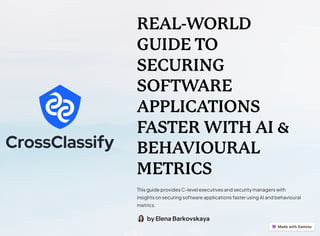The new MFA security gap deciphered тАФ Real-world guide on how to fix it For C-Level Executives & Security Managers
- 1. REAL-WORLD GUIDE TO SECURING SOFTW ARE APPLICATIONS F ASTER WITH AI & BEHA VIOURAL METRICS This guide provides C-level executives and security managers with insights on securing software applications faster using AI and behavioural metrics. by Elena Barkovskaya
- 2. Problem Statement 1 Rising Cybercrime Cyber attackers are increasingly sophisticated, utilizing AI-driven technologies to target businesses. 2 Data Breach Costs Data breaches are becoming more frequent and costly, with the average cost reaching $4.45 million in 2023. 3 Vulnerable SMBs Many small and medium businesses lack proper security solutions, making them vulnerable to attacks. 4 Misconceptions Common misconceptions about cybersecurity hinder effective security measures.
- 3. Data Breach Expenditures Detection & Escalation Activities to detect and respond to a breach, including forensic investigation, crisis management, and communication. Notification Activities to notify data subjects, regulators, and third parties about the breach, including communication and legal compliance. Post-Breach Response Activities to assist victims of a breach, including credit monitoring, identity protection, and legal expenses.
- 4. Myth #1: Fraudulent Attacks Affect Organizations Only Financially Reputation Data breaches can severely damage a company's reputation, leading to loss of customer trust and business. Loyal Customers Customers may be hesitant to do business with companies that have experienced data breaches, leading to lost revenue. Legal Prosecution Companies may face legal action and fines for failing to protect customer data, resulting in significant financial penalties. Best Employees Data breaches can lead to employee dissatisfaction and turnover, impacting the company's workforce and productivity.
- 5. Myth #2: Security Solutions Evolve So Rapidly That Soon Cyber Threats Will Be All Gone And Forgotten 1 Rapid Evolution Cyber attackers are constantly evolving their techniques, staying ahead of security solutions. 2 Emerging Threats New technologies like quantum computing and AI- powered malware pose significant threats to cybersecurity. 3 Growing Costs Cybercrime costs are projected to reach $10.5 trillion annually by 2025, highlighting the increasing severity of the problem.
- 6. Myth #3: Corporate Emails Are The Main Targets Of Cyber Attacks 1 Web Applications Web applications are now the primary target of cyberattacks, making security a crucial aspect of online businesses. 2 Vulnerability Businesses that provide web application logins must prioritize security to protect customer data and prevent breaches.
- 7. Myth #4: MF A Is An Answer MF A Bypass Fraudsters can bypass two-factor authentication through various methods, including purchasing stolen session tokens or exploiting MFA fatigue attacks. Adaptive MF A CrossClassify's Adaptive MFA solution addresses common MFA vulnerabilities, providing a more secure and robust authentication process.
- 8. Myth #5: SMBs Are T oo Small T o Be Attacked Number of Employees Cost of Data Breach (USD, mln) Less than 500 Increased by 13% since 2022 5001-10000 Reduced by 16.5% since 2022
- 9. Solution: CrossClassify Behavioural Biometrics AI-powered behavioural biometrics analyzes user behaviour patterns to detect fraudulent activity, providing a robust security solution. Scalability CrossClassify's solution is scalable, growing with your business and offering comprehensive protection. Accuracy The solution utilizes over 1 million factors to detect suspicious activity, ensuring high accuracy and effectiveness. Frictionless UX CrossClassify's Adaptive MFA provides a seamless user experience, minimizing friction and maximizing customer satisfaction. Read more about the solution
- 10. Conclusion Businesses must prioritize proactive security measures to safeguard their data and mitigate risks. CrossClassify's AI-powered solutions offer a cost-effective and efficient way to protect online applications and ensure a secure digital ecosystem for everyone.










